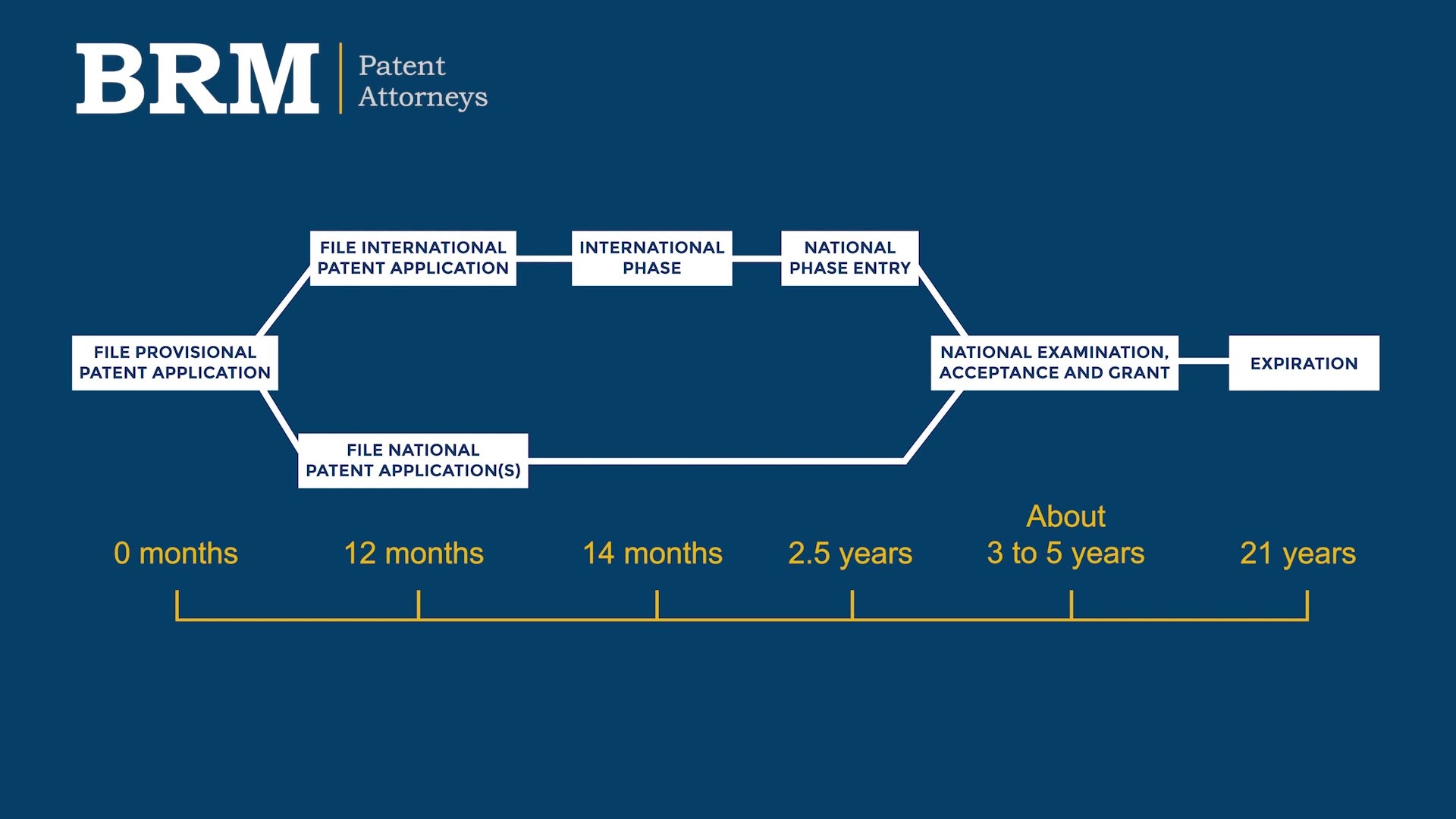IDEA OR INVENTION?
Can you patent an idea?
If the idea is a new product or process that has practical advantages, we call it an invention and there’s a good chance that it’s patentable. See Patent Fundamentals.
AUSTRALIA
How to patent an idea in Australia – 5 key steps
INTERNATIONAL
How to patent an idea internationally – 9 key steps
- Keep it secret
- Assess the business case
- Search for similar pre-existing technology (optional)
- File an Australian provisional patent application
- Ask IP Australia to search for similar pre-existing technology (optional)
- File an international patent application (“PCT Application”)
- Work with the international examiner
- Select and pay for the individual countries of interest
- Work with the national patent examiners.
As a general rule, the idea should be kept secret and not sold or commercially used until a patent application is filed. Australia, New Zealand, the US, Canada and some other countries have 12 month grace periods. These grace periods are exceptions to the general rule that may allow you to secure a valid patent if your idea is no longer secret.
IS IT WORTH PATENTING?
Assess the business case
Patenting requires a significant investment. That investment should be weighed against the benefits of patenting (principally, the right to stop others making, using and selling versions of your idea). See How much does a patent cost?
SEARCHING – NOVELTY / PRIOR ART / PRE-FILING
Search for similar pre-existing technology
To qualify for a valid patent, the idea must be new and non-obvious compared to what is already publicly known. Searching for relevant pre-existing technology is a prudent early step, particularly if you are aiming to patent in multiple countries.
Decoding the jargon:
- Novelty, prior art and pre-filing searches are all the same thing;
- ‘Novel’ means ‘new’;
- ‘Prior art’ refers to what is publicly known before a patent application is filed; and
- this type of search is often conducted before a patent application is filed.
The search may reveal that your idea is not new in which case the search is an inexpensive way to get the bad news.
Searching often reveals technologies that are similar but not quiet the same as the idea. The points of difference may well be patentable and having the relevant search results in advance helps to prepare a better patent application.
SET A PRIORITY DATE
File an Australian provisional patent application
A provisional patent application is a place marker that reserves your priority to patent an invention. Filing an adequate Australian provisional patent application sets the ‘priority date’ This is the key date that patent examiners all around the world will use when assessing whether your idea qualifies for a patent.
Preparing and filing a provisional patent application usually takes a week or two. Once it’s filed:
- it is no longer necessary to keep the idea secret – you can go public without harming your rights in what you’ve invented so far;
- you can (and should) mark and market your idea as ‘patent pending’ to put potential imitators on notice; and
- your idea is protected in the sense that if an imitator enters the market, you can accelerate the process to secure a patent and then to stop the imitator.
The Australian Patent Office is called IP Australia. When you have a pending Australian provisional patent application, you can ask IP Australia to conduct an “International-Type Search” for pre-existing technology that might stop you getting a patent.
This search is similar to the pre-filing search earlier on in the process: it’s optional but recommend if you’re aiming to patent in multiple countries. And it’s not only a second pass. Your focus may have shifted to different aspects of your idea in view the earlier search results or recent technical developments.
The International-Type Search is based on the wording of the patent application or updated wording we supply, so the search tests the wording as well as testing the idea.
AUSTRALIAN AND/OR PCT APPLICATION
File non-provisional patent application(s)
Provisional patent applications only last for 12 months. Within that period, you will need to file one or more non-provisional applications if you wish to continue.
An international patent application is a good option if you’re aiming to patent in multiple countries. On the other hand, if you’re only after one or two countries, separate national applications would be better value (and you can skip ahead to the ‘Work with the national patent examiners’ heading below).
International patent applications are often called ‘PCTs’ or ‘PCT applications’ because they come about from an international agreement called the Patent Cooperation Treaty.
THE INTERNATIONAL PHASE
Work with the international examiner
If an Australian files an international patent application, the Australian Patent Office will act as the International Searching Authority and provide preliminary feedback on the idea.
If the feedback is not immediately favourable, you might respond with a combination of legal argument and amendments to secure favourable feedback.
This is another stage of testing your idea that helps to build confidence that your idea is patentable, and to refine the wording of the patent application, before the major step of ‘entering the national phase’.
NATIONAL PHASE ENTRY
Select and pay for the individual countries of interest
International patent applications last until about two and a half years after the first application. Then it’s time to pick and pay for the individual countries or regions of interest. This is called ‘entering the national phase’.
There are regional patent systems in Europe, Africa (OAPI and ARIPO), the Arabian Peninsula and Eurasia, but for the most part patents are granted country-by-country.
NATIONAL EXAMINATION
Work with the national patent examiners
In the months and years following national phase entry or filing separate national patent applications, each country or region will conduct its own examination process.
Patent examiners will search for relevant pre-existing technology and raise objections if they consider the patent application to cover anything that is not new or is obvious compared to what was publicly known before the initial patent application was filed.
It is routine to face objections and to respond with a combination of legal argument and amendments to restrict the patent coverage.
Corresponding with patent examiners entails costs and the risk that (after incurring all the costs to get to this point) a national examiner will locate search results that show your idea is not new and is therefore not patentable. The optional searching steps recommended earlier on reduce these costs and risk.
GETTING THE PATENT
Allowance and grant
If the examiner is persuaded that your invention is patentable, they will allow the patent application. In Australia, we call this acceptance. Usually, a patent is granted on the application a few months later.
Patents are often grant about 4 to 5 years after the first patent application is filed. Some countries such as India and Brazil can take much no longer.
OBSERVATIONS AND OPPOSITIONS
Competitors working against you
Third parties can intervene to slow or block your path to a patent, although the vast majority of patent applications go without any such intervention.
Third party intervention might entail supplying patent examiners with ‘third party observations’ identifying relevant pre-existing technology and/or other grounds for examiners to object.
Formal opposition is another possibility in most countries. The process and timing vary from country to country.
In Australia, when an application is accepted, the acceptance is advertised in an official journal (usually a week or two later) and then competitors have 3 months to formally oppose the grant of a patent on the application.
Usually, the 3-month date passes and a patent is granted shortly thereafter. If an opposition is filed, you will be given an opportunity to respond to the opponent’s arguments before the Patent Office makes a decision.
AFTER GETTING THE PATENT – EUROPE
European validation
After a European patent is granted, it must be validated in the individual countries of interest and/or as a unitary patent covering 17 countries.
MAINTAINING THE PATENT
Renewal fees
Most countries require annual renewal fees to be paid if the patent is to be maintained. The Australian fees commence of the fourth anniversary of the first non-provisional filing (i.e., about the 5-year mark) and are charted on our patent costs page.
STRATEGIC DELAY
Why does it take so long?
The ordinary patent application process takes years. It is possible to expedite the process but usual not to. The ordinary delays defer cost and preserve the flexibility to amend the patent coverage (which flexibility is limited when a patent is granted).
The delay doesn’t have to slow you down and your idea is protected in the meantime. Once an adequate patent application has been filed, publishing, making, using and selling (etc) your idea will not harm your patent rights in what you have invented so far.
If an infringing product appears in the market before your patent is granted, you can accelerate the process, get the patent and then stop the infringer.
PATENT COSTS
How can I get a patent with no money?
You can’t. At the very least, Patent Office fees must be paid. Additionally, you are unlikely to secure an effective patent without a patent attorney. The patent attorney’s fees are likely to be much higher than the Patent Office fees. More on patent costs and patent attorney fees.
You may be able to attract investors to pay for the patenting process but it’s important to keep your idea secret and have a confidentiality agreement with potential investors before you tell them about your idea.
UNPATENTED INTELLECTUAL PROPERTY
Can you sell an idea to a company without a patent?
Yes, but it’s important to keep your idea secret and have a confidentiality agreement with the company before you tell them about your idea.
NON-PATENT INTELLECTUAL PROPERTY
How do I protect an idea without a patent?
You could simply keep your idea as a ‘trade secret’ or look to another form of intellectual property such as design registration, trade mark registration and copyright, although patents are often the only effective form of protection for new product ideas.
IT’S GOOD TO TALK
Any questions?
Please contact us when you are ready to start the conversation.


